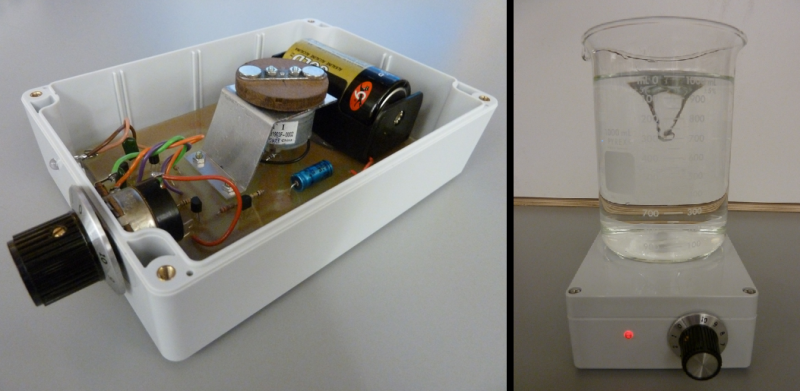Stirrers are used in chemistry and biology labs to mix containers full of liquids. Magnetic stirrers are often preferred over the mechanical types because they are more sterile, easier to clean and have no external moving parts. Magnetic stirrers quickly rotate a magnet below the glass beaker containing the liquids that need mixing. The magnetic field travels effortlessly through the glass and reacts against a small magnetic cylinder called the stir bar. The spinning stir bar mixes the contents and is the only part of the mixer that touches the liquids.
[Malcolm] built his own magnetic stirrer. Unlike some DIY stirrers out on the ‘web, this one gets an “A” for aesthetics. It’s clean white lines allow it to look right at home in the professional laboratory. The graduated knob looks good and is functional too as the the potentiometer it is attached to allows multiple mixing speeds. Surprisingly, a D-size battery is all that is needed to power the stirrer. Most of the parts required for this project can be found in your spare parts bin. [Malcolm] has written some excellent instructions on how he made the stirrer including a parts list and schematics.
Want to make a magnetic stirrer but aren’t into chemistry or biology? No worries… I pity the fool who don’t build one of these….















Points for using a semi water resistant enclosure.
yep,. although would be better to have it inverted to keep the screws away from the liquid
The gasket on this enclosure avoids the screws, so any liquids that get into the screw holes would not compromise the integrity of the enclosure.
Yes, but if the screw heads were to rust, then you could never replace the battery.
The threads are brass.
threads may be brass but when a steel screw rusts it expands in the brass insert and grabbs it, causing the insert to spin in its casing, that is ofcourse if your lucky enough to be able to get a purchase on the screw head. I doubt there is an auto mechanic on the planet who hasnt had to deal with this horrible situation. that said some silicone grease on the screw heads and anti-sieze on the threads and i doubt itll ever be an issue. and i agree with the fella who said turning it upside down is a bad idea, the screws will then be immersed in the liquid, perhaps un-noticed, and cappilary action will trash em.
Tuning it upside down is still easier.
That doesn’t necessarily keep it away from the liquid though as, if liquid has sloshed out, it’ll be on the working surface which you’ve now immersed the screw heads in.
Equally, if you were that paranoid about liquid then you wouldn’t put a pot through the panel (while water-sealed versions exist, they’re not exactly off the shelf items and there are easier solutions around such as capacitive displays or, y’know, IP6 rated buttons).
The case isn’t on the ground, it’s got rubber feet.
The screws are stainless steel.
The first rule of design – don’t introduce unnecessary failure points into the design.
i want to build one
Another simple way to make a magnetic stirrer is to take a regular computer fan and glue two magnets onto the blades (on opposite sides so it’s balanced).
One of the larger sizes for sure, say 5 inch (12cm).
I’ve been meaning to build one of these….
I would add a coffee pot hot plate underneath as well. I don’t know how the metal plate would affect the flux to the stirrer though. Maybe a hole drilled in the middle of the plate.?
This is a nice simple one, but here’s an alternative.
Use a stepper driver, a 555, and a few coils to make a solid state version. The whole thing could be potted in epoxy leaving only the potentiometer and the power supply exposed to liquids.
“It’s clean white lines allow it to look right at home…”
Do you guys even have editors…?
Of course they do, they’re just bad at it.
Sadly, the picture of the front of it shows it only going up to ten. Back in about 2005 or so, this other one went up to eleven. That’s one more.
http://blog.tenderbutton.com/?p=106
Too bad the wayback machine didn’t pick up the photograph. It really does go up past ten. All the way to…
ok so now that this is been done , i want to build one that is MASSIVE, driven off mains power, and has the power to stir a 55gal drum